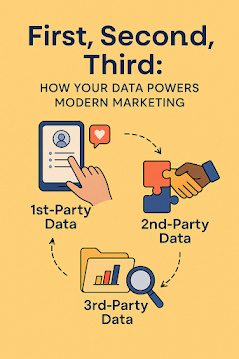First, Second, Third: How Your Data Powers Modern Marketing
Hey marketers, welcome back.
Ever searched for a pair of headphones and then started seeing ads for them on Instagram, Flipkart, and Spotify within hours? You didn’t sign up for a campaign. But you walked right into one.
This is not just retargeting. It is the layered use of first-party, second-party, and third-party data in digital marketing.
In a world where privacy concerns are rising and cookies are crumbling, understanding how these data types work is not just important. It is essential.
Let’s break down the three types of consumer data, how Indian brands are using them, and why marketers need to get serious about owning their data strategy.
What Is First, Second, and Third-Party Data?
First-party data is information you collect directly from your customers. This includes app behavior, purchase history, website clicks, form submissions, and feedback. Think of what Swiggy learns from your order frequency or what Amazon tracks through your wishlist.
Second-party data is someone else’s first-party data that you get access to through partnerships. For example, Tata Neu using BigBasket user data to recommend deals across Croma or AirAsia.
Third-party data is aggregated data collected by external providers and sold to advertisers. This includes cookie-based targeting, interest groups, and anonymised audience profiles.
The Shift Toward First-Party Data
Indian brands responded by doubling down on first-party data. Instead of renting audiences, they started building their own.
Examples:
-
Swiggy uses your browsing and order timing to push context-specific discounts and limited time offers.
-
Tata Neu creates a unified data layer across retail, finance, and travel to build behaviour-driven targeting across brands.
-
Zomato uses first-party signals like cuisine preference, location, and frequency to power personalised Gold and Pro recommendations.
These actions give marketers more control, better attribution, and faster campaign response.
Second-Party Data in Action
Second-party data is rising quietly but powerfully. It works best when two brands have non-competing but complementary customer bases.
Examples:
-
MakeMyTrip and HDFC SmartBuy collaborate on travel bookings with bank-driven discounts, powered by shared customer behavior.
-
Amazon Pay uses merchant data to offer contextual credit products via ICICI and Axis Bank.
These data relationships are not about buying information. They are about exchanging signals that deepen segmentation and relevance.
The Decline of Third-Party Data
Third-party cookies are not just less accurate. They are also vanishing.
Platforms like Meta and Google are pushing advertisers to rely on first-party signals, conversion APIs, and in-app user actions.
Ad networks are losing dominance. Owned data is gaining ground.
Zero-Party Data Is Growing
There is also a new player in the mix. Zero-party data is information your customer gives you directly and voluntarily. It is the most honest form of personalisation.
Examples:
-
The Derma Co runs product quizzes to collect user skin concerns, then builds custom routines and retargets accordingly.
-
Lenskart asks about face shape and style preference to improve product discovery and visual appeal.
This data is clean, consented, and highly actionable. It can boost conversions and customer trust at the same time.
For Marketers, Here’s the Data Strategy
If you are still planning campaigns based on rented data, you are already behind.
The playbook is changing:
-
Collect clean first-party data through apps, loyalty programs, and email
-
Use second-party data to strengthen your segmentation depth
-
Invest in zero-party data for direct input from customers
-
Reduce third-party data dependency before it becomes a liability
-
Respect consent and build transparent opt-in experiences
The more data you own, the more meaningful your marketing becomes.
Final Thoughts: Data Is Not a Tactic. It Is the Strategy.
Your customer data is no longer just a list of names and clicks. It is your competitive edge.
First-party data gives you trust and control. Second-party data gives you reach. Zero-party data gives you precision. Third-party data gave you scale. But that era is ending.
So the next time you launch a campaign, ask yourself:
Is this campaign powered by what you know or what someone else assumed?
Because good marketing guesses. Great marketing knows.
- MK



Good
ReplyDelete